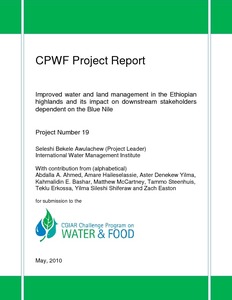Resource information
Improved water and land management in the Ethiopian highlands and its impact on downstream stakeholders dependent on the Blue Nile – short title Upstream-Downstream in Blue Nile River project is one of the projects in the Nile Basin supported by the CPWF. It was implemented during from 2007 to 2009 through a partnership of 8 institutions. The Blue Nile is the major tributary of the Nile River, contributing about 62% of the Nile flow at Aswan. About two thirds of the area of this densely populated basin is in the highlands and hence receives fairly high levels of annual rainfall of 800 to 2,200 mm. However, the rainfall is erratic in terms of both spatial and temporal distribution with prolonged dry spells and drought often leading to crop failures. Currently, water resources are only marginally exploited in the upper basin but are much more developed in the downstream reaches. The population, located in the downstream part of the Blue Nile, is dependent on the river water for supplementary irrigation and energy production. Canal and reservoir siltation is a major problem, adding the burdens of poor riparian farmers. This project was envisaged to improve the scientific understanding of the land and water resources of the basin, and hypothesized that with increased scientific knowledge of the hydrological, watershed, and institutional processes of the Blue Nile in Ethiopia (Abbay), constraints to up-scaling adaptable best practices and promising technologies (technical, socio-economic, institutional) could be overcome, which will result in significant positive impacts for both upstream and downstream communities and state.


